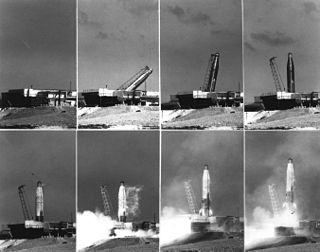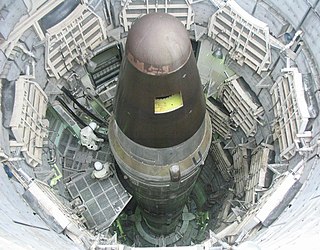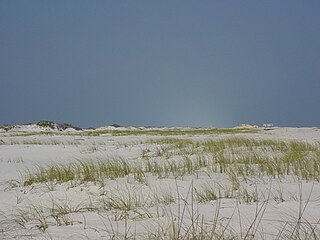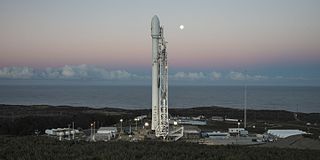 W
WLaunch Complex 576 is a group of rocket launch pads at Vandenberg Air Force Base. The pads were used from 1959 until 1971 to launch SM-65 Atlas missiles. The site was also known as Complex ABRES. Pads in Area 576 include 576A-1, 576A-2 and 576A-3, 576B-1, 576B-2 and 576B-3, 576-C, 576-D, 576-E, OSTF-1 and OSTF-2.
 W
WThe Titan Missile Museum, also known as Air Force Facility Missile Site 8 or as Titan II ICBM Site 571-7, is a former ICBM missile site located at 1580 West Duval Mine Road, Sahuarita, Arizona in the United States. It is located about 40 km (25 mi) south of Tucson on I-19. It is now a museum run by the nonprofit Arizona Aerospace Foundation and includes an inert Titan II intercontinental ballistic missile in the silo, as well as the original launch facilities.
 W
WBOMARC Site RW-01 is a 75-acre (30 ha) fenced-off site contaminated primarily with "weapons-grade plutonium (WGP), highly-enriched and depleted uranium." On 7 June 1960 an explosion in a CIM-10 Bomarc missile fuel tank caused the accident and subsequent contamination. The explosion occurred at Launcher Shelter 204, McGuire AFB, Ocean County, New Jersey, approximately 16.1 miles (25.9 km) south-southeast of Trenton, New Jersey. Launcher Shelter 204 was one of fifty-four located at McGuire AFB, operated by the 46th Air Defense Missile Squadron.
 W
WCape Canaveral Air Force Station (CCAFS) is an installation of the United States Space Force's 45th Space Wing, located on Cape Canaveral in Brevard County, Florida.
 W
WLaunch Complex 34 (LC-34) is a launch site on Cape Canaveral, Florida. LC-34 and its companion LC-37 to the north were used by NASA from 1961 through 1968 to launch Saturn I and IB rockets as part of the Apollo program. It was the site of the Apollo 1 fire, which claimed the lives of astronauts Gus Grissom, Ed White, and Roger Chaffee on January 27, 1967.
 W
WLaunch Complex 36 (LC-36)—formerly known as Space Launch Complex 36 (SLC-36) from 1997 to 2010—is a launch complex at Cape Canaveral Air Force Station in Brevard County, Florida. It was used for Atlas launches by NASA and the US Air Force from 1962 until 2005.
 W
WLaunch Complex 45 (LC-45) is a former launch complex created to launch the Roland missile. However, it was never used prior to its destruction, and Launch Complex 46 is now in its location.
 W
WLaunch Complex 47 (LC-47) is a launch pad for sounding rockets located at the north end of Cape Canaveral Air Force Station, Florida. It is the smallest launch complex used in the air force station. The complex features a small blockhouse a few yards from the pad, containing vehicle-specific hardware. Between 1984 and 2008, 531 sounding rockets were launched from pad 47. All weather rocket operations were relocated here from Launch Complex 43 in 1984 in order to make room for the construction of Launch Complex 46.
 W
WSpace Launch Complex 37 (SLC-37), previously Launch Complex 37 (LC-37), is a launch complex on Cape Canaveral, Florida. Construction began in 1959 and the site was accepted by NASA to support the Saturn I program in 1963. The complex consists of two launch pads. LC-37A has never been used, but LC-37B launched uncrewed Saturn I flights and was modified and launched Saturn IB flights, including the first (uncrewed) test of the Apollo Lunar Module in space. It was deactivated in 1972. In 2001 it was modified as the launch site for Delta IV, a launch system operated by United Launch Alliance.
 W
WSpace Launch Complex 40 (SLC-40), previously Launch Complex 40 (LC-40) is a launch pad for rockets located at the north end of Cape Canaveral, Florida.
 W
WSpace Launch Complex 41 (SLC-41), previously Launch Complex 41 (LC-41), is an active launch site at Cape Canaveral Air Force Station.· As of 2020, the site is used by United Launch Alliance (ULA) for Atlas V launches. Previously, it had been used by the USAF for Titan III and Titan IV launches.
 W
WThe Space Launch Complex 46 (SLC-46), previously Launch Complex 46 (LC-46), is a launch complex at Cape Canaveral Air Force Station operated under license by Space Florida for Athena rocket launches.
 W
WThe Minuteman Missile National Historic Site was established in 1999 to illustrate the history and significance of the Cold War, the arms race, and intercontinental ballistic missile (ICBM) development. This National Historic Site preserves the last remaining Minuteman II ICBM system in the United States. 450 of the newer Minuteman III missiles are still on active duty at Malmstrom AFB, Montana, Minot AFB, North Dakota, and F. E. Warren AFB, Wyoming.
 W
WThe Operational Silo Test Facility (OSTF) is a former United States Air Force intercontinental ballistic missile launch facility at Vandenberg Air Force Base, California, United States. It was a developmental launch site for the silo-based Titan and Atlas missile series.
 W
WSanta Rosa Island is a 40-mile (64 km) barrier island located in the U.S. state of Florida, thirty miles (50 km) east of the Alabama state border. The communities of Pensacola Beach, Navarre Beach, and Okaloosa Island are located on the island. On the northern side of the island, are Pensacola Bay on the west and Choctawhatchee Bay on the east, joined through Santa Rosa Sound.
 W
WSpace Launch Complex 3 (SLC-3) is a launch site at Vandenberg Air Force Base that consists of two separate launch pads. SLC-3E (East) is currently used by the Atlas V launch vehicle, while SLC-3W (West) has been demolished.
 W
WSpace Launch Complex 4 (SLC-4) is a launch and landing site at Vandenberg Air Force Base with two pads, both of which are used by SpaceX for Falcon 9 launch operations; operating as Landing Zone 4 (LZ-4) for SpaceX landings.
 W
WSpace Launch Complex 5 (SLC-5) was a launch pad at Vandenberg Air Force Base in California, United States. It was previously part of the Point Arguello Naval Air Station, during which time it was designated Launch Complex D or LC-D. Constructed in 1961, it was used by 69 Scout rockets between 1962 and 1994. Satellites launched from the complex included Transit, OV3, Explorer and P35 spacecraft. Most of the satellites launched from SLC-5 were placed into low Earth orbits, or low medium Earth orbits.
 W
WThe 374th Strategic Missile Squadron is an inactive United States Air Force unit. It was last assigned to the 308th Strategic Missile Wing, stationed at Little Rock Air Force Base, Arkansas.
 W
WLaunch Complex 576 is a group of rocket launch pads at Vandenberg Air Force Base. The pads were used from 1959 until 1971 to launch SM-65 Atlas missiles. The site was also known as Complex ABRES. Pads in Area 576 include 576A-1, 576A-2 and 576A-3, 576B-1, 576B-2 and 576B-3, 576-C, 576-D, 576-E, OSTF-1 and OSTF-2.
 W
WSpace Launch Complex 10, or Missile Launch Complex 10, is located on Vandenberg Air Force Base in Lompoc, California. It was built in 1958 to test ballistic missiles and developed into a space launching facility in 1963. Prior to 1966 Space Launch Complex 10 West was known as Vandenberg AFB Pad 75-2-6. It remains a rare pristine look at the electronics and facilities created in that era that helped the United States grow its space capabilities.
 W
WWhite Sands Space Harbor (WSSH) is a spaceport that was formerly used as a Space Shuttle runway, a test site for rocket research, and the primary training area used by NASA for Space Shuttle pilots practicing approaches and landings in the Shuttle Training Aircraft and T-38 Talon aircraft. With its runways, navigational aids, runway lighting, and control facilities, it also served as a backup Shuttle landing site. WSSH is a part of the White Sands Test Facility, and is located approximately 30 miles west of Alamogordo, New Mexico, within the boundaries of the White Sands Missile Range.